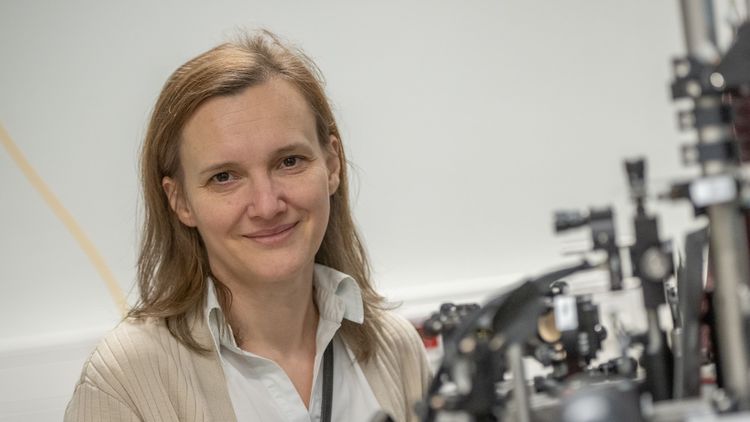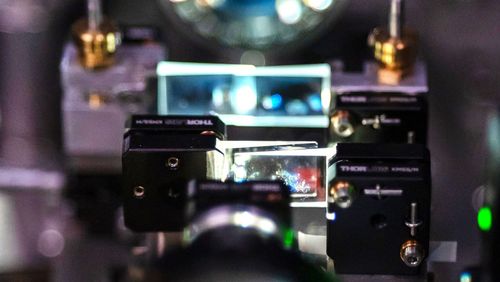Experimental physicist Ana Predojević from Stockholm is currently a Helene Lange Visiting Professor at the University of Oldenburg. The renowned researcher is one of very few women in one of the trendiest fields in physics.
Ana Predojević feels at home in the nanoworld – the bizarre cosmos of quantum physics. She studies light particles (photons) that are linked to each other in wondrous ways. With her Quantum Photonics research group at Stockholm University in Sweden, she creates light sources that are particularly effective at generating these "entangled" particles as well as single photons. "This kind of light source is needed for quantum communication or for photonic quantum computers," the physicist explains.
Predojević shares her passion for quantum light with Oldenburg physicist Professor Dr Christian Schneider. The two scientists have been working together for years, and their cooperation is particularly intense right now as Predojević is currently a Helene Lange Visiting Professor at the University of Oldenburg. In addition to her joint research with Schneider and his research team, "promoting the careers of young female scientists" also features prominently on her agenda during her time in Oldenburg. With the Helene Lange Programme, the University aims to bring to Oldenburg outstanding female academics in subject areas where women are strongly underrepresented. The Helene Lange Professors serve as role models and contact persons for female students, doctoral candidates and post-doctoral researchers. In the coming summer semester, Predojević plans to play an active role in the University's mentoring programme for female academics.
Compared to other natural sciences, physics – like computer science and engineering – is still a predominantly male domain. Statistics show that in many Western countries the proportion of female students has remained stagnant at between 20 and 30 percent for years, and only about one in ten professorships in the field is held by a woman. The situation is similar in Oldenburg. In 2021, 23 percent of the University's physics students were female, although 30 percent of the degrees and doctorates in physics were earned by women. As regards professorships, the figure is 18 percent: there are three female professors and 14 male professors at the Institute of Physics.
Where physics is popular with women
When she was studying physics at the University of Novi Sad in Serbia, Ana Predojević was able to see for herself that things can be different. "In my year, we were all women," she recalls. Since then she has done research in Spain, Austria, Germany and Sweden – and found that of all these countries Spain offers the best conditions for women. "There are many female physics students there, and also many female professors," she says. "It seems to be more taken for granted and socially accepted there that physics is a subject for women."
For Predojević herself, studying physics was the natural choice. "I always wanted to be a scientist and I found that physics was the most interesting science," she says. She finds it fascinating to investigate completely new phenomena that no one has ever studied before. The real thrill: "When you encounter a problem, you can't ask anyone, you have to solve it yourself."
This is especially true in her particular area of expertise, quantum photonics – one of the trendiest research fields in physics right now. Quantum light – or light with special properties that cannot be described by classical physics – forms the basis for cutting-edge information processing technologies. Its applications in quantum computers and quantum cryptography have developed rapidly in recent years. "When I started my doctoral thesis about 20 years ago, quantum light sources were still a relatively specialised field," Predojević observes.
Testing new light sources
The physicist was involved in this area from the very beginning. In the course of her work she has investigated not just entangled photons but all kinds of strange nanoworld phenomena. She spends many hours in the lab setting up experiments and characterising and testing new light sources. Her research has been funded by the Austrian Science Fund under the auspices of the prestigious Lise Meitner and Elise Richter programmes, among others. "Ana Predojević is without doubt one of the leading figures in the field of semiconductor quantum optics," says Christian Schneider, who is proud to have brought the physicist to Oldenburg.
Their current collaboration has already proven fruitful: "We have achieved interesting results in the last few weeks and plan to submit another joint publication and a project proposal shortly," says Schneider. Predojević is also pleased with the results of her stay – and glad that February in Oldenburg feels considerably more spring-like than it does in Stockholm. The fact that there are no other women in her research group at the moment doesn't detract from her mission as a female role model, she explains, adding: "I can also be a role model for my colleagues."




